Candidate-centric approach to hiring: 10 lessons from Jill Macri (Airbnb)

In his fictional letter, author & entrepreneur Bryan Adams discusses his tumultuous relationship with recruitment industry. The poignant letter focuses on the importance of filling open racks at the speed of light with a simultaneous lack of respect for candidates involved in the process. Here’s what he has to say:
“We always said we’d put the candidates first. (…). I’m not completely blaming you, I know you’re under a tremendous amount of pressure at work. I know you’ve got to deal with explaining a high attrition rate as well as filling a sudden spike of vacancies right now (…). Last week you even completely ignored me for two days just because I suggested that you should call the candidates with some meaningful feedback – It would have meant so much.”
Sadly, Adams is speaking the minds of many recruiters and even more applicants.
The solution is simple
There are two main approaches to the hiring process:
- Filling open positions (client-focused)
- Finding the right person for the open position (candidate-centric)
Although these two approaches look fairly similar, placing the emphasis on a different component of the hiring equation makes a tremendous difference.
In this post, we look at the hows and whys of candidate-centric hiring.
Why candidate-centric approach is the future
As a recruiter, you spend your days trying to fill vacancies but the people you interview live very different lives from your own. They are usually unfamiliar with or unused to many of the things you take for granted.
Typically candidates aim to change jobs as little as possible because they are afraid to be seen as job hoppers. That’s why they get easily stressed in interview rooms or hesitate when they discuss terms with you. They’re just not used to the situation the way you are, plus they want to be sure they’re making the right decision.
How can you understand them better?
Think about why you get to meet these people in the first place. It’s not money or lack of love to their bosses which makes them talk to you about a potential job move. A 2015 LinkedIn research based on 10,000+ job switchers established that career opportunities were the number one reason why people changed jobs.
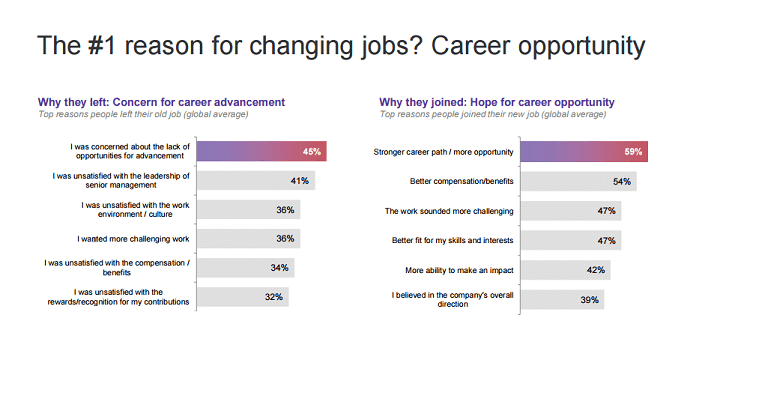
Image source: LinkedIn
Findings of MRINetwork study further indicate that 72% of candidates are driven by advancement opportunities which are the number one reason why people change jobs.
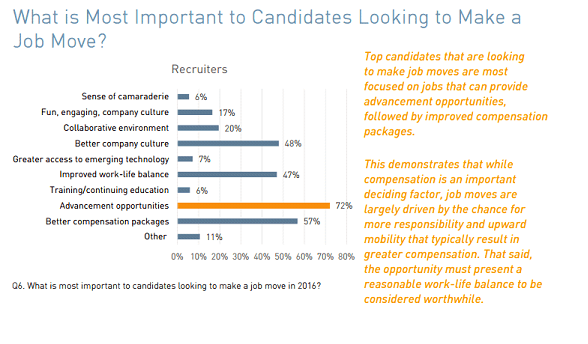
Image source: MRINetwork
You’ll be interested to know that being nice to people and treating them with respect pays off professionally because it means getting better hires for your organization.
A Mattersight study (via Marketwired) sheds light on the influence of personal connections formed at the time of the interview. According to the research, 80% of job seekers “say they would take one job over another based purely on personal connections formed during the interview”.
What this means for you is that on your typical day of work, you meet people who:
- Are looking for new growth opportunities,
- Want to be treated nicely and with respect.
Treating candidates courteously has another important business implication: there’s money involved.
Candidate-centric approach = money
Think of candidate-centric hiring as a valuable tool with a power to bring you dollars.
Example?
Virgin Media released the information on the influence of bad hiring processes on the company’s bottom line. The “Rejected Candidate Survey” revealed that 18% of applicants were Virgin Media customers, and approximately 6% of all applicants switched to their competitors as a result of a poor hiring experience with a total of £4.4 million in lost revenue.
You should also get familiar with a CareerBuilder study which found that “82% of employers think there’s little to no negative impact on the company when a candidate has a bad experience during the hiring process”. That’s actually far from true as:
- 58% of applicants are less likely to buy from a company they applied to if they didn’t get a response,
- 69% of candidates are less likely to make a purchase from a company if they have a bad experience during the interview.
A favorable candidate experience has a reverse effect:
- 69% of applicants are more likely to buy from a company which treated them with respect during the hiring process.
Candidate-centrism fosters positive company reputation
In some organizations talent acquisition teams speak to more people than customer success teams on a typical day at work. Unfortunately, despite its scope, the hiring process is still not given the attention it needs.
According to the White House Office of Consumer Affairs (via Help Scout), news of bad service travels at the speed of light and it reaches “more than twice as many ears as praise for a good service experience”. This holds true also in the case of hiring – people are naturally intrigued by stories of bad hiring experience which go viral, especially if they’re shocking or if the company is generally associated with high quality of service.
Here’s a recent example of a bad hiring experience story which spread like wildfire:
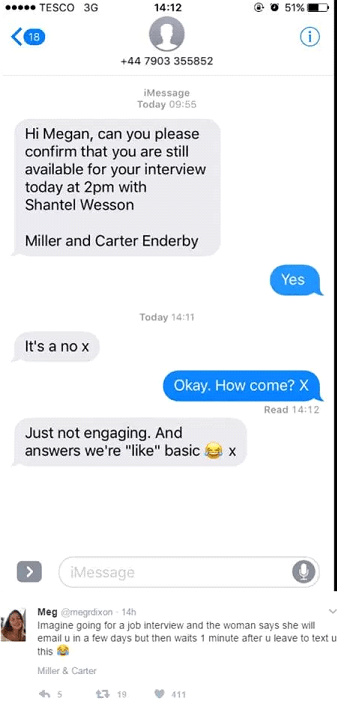
Source: The Sun
Although candidate-centrism is a fairly simple concept, making the transition from a client-focused culture to a candidate-centric one is a tough nut to crack. If you’re thinking of embarking on the candidate-centric journey, there’s someone I’d like you to meet.
Say hello to Jill Macri
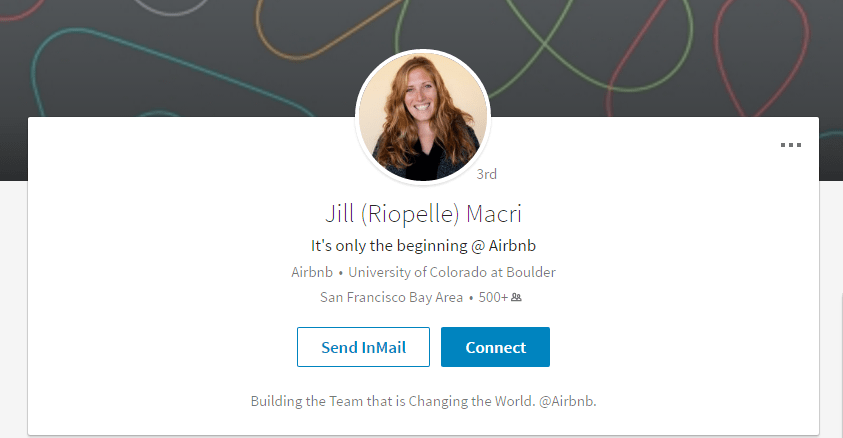
Image source: LinkedIn
Jill Macri is Global Head of Recruiting at Airbnb and she knows candidate-centrism inside out. In her informative Talent Connect presentation, she says that “nobody gives a bad candidate experience on purpose”. Sadly, that doesn’t mean it doesn’t happen a lot.
Macri herself pleads guilty of providing bad candidate experience in the past:
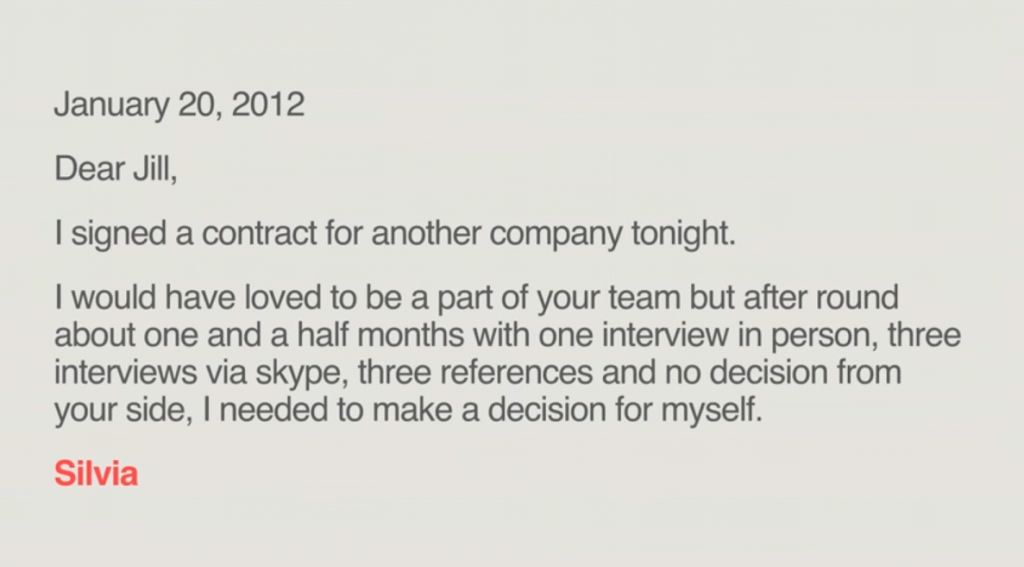
Image source: YouTube
She states that this one email (coming from a person they actually wanted to hire) sums up what people went through at this point at Airbnb. The company had trouble getting back to candidates in a timely manner and managing the recruitment process efficiently.
Because it wasn’t working, their recruitment process was then taken down completely and built from scratch.
Here’s what you can learn from how Airbnb’s route to designing a candidate-centric hiring culture.
How to make the transition
- Storyboard your current candidate journey
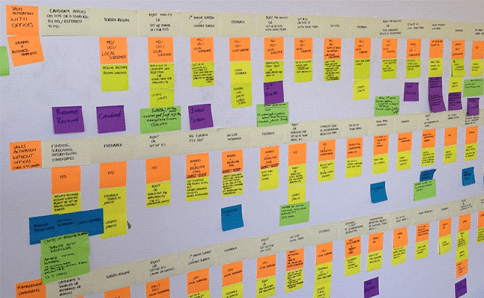
Image source: Business Solutions on LinkedIn
The aim of the storyboarding exercise is to map “the entire journey, frame by frame to either offer or rejection”.
Macri argues that having a roadmap of customer experience allows you to:
- Define moments that are universal – regardless of job title and location, such as phone call or on-site interview, and discovery of the company,
- Ensure the new recruitment process is scalable (No talk of pain points at this time, focus on the ideal picture),
- Get in the shoes of the candidate.
- Get insights from recent hires
Preconceived notions of candidate expectations are one of the biggest enemies of candidate-centric hiring. To see themselves through the eyes of other people, Airbnb recruitment team organized a booth in the lunchroom where they asked their recent hires for feedback regarding their experience.
They used green and red post-it notes to see which of the events were unpleasant or caused discomfort, and which were perceived as positive. Macri confesses they saw a lot of red and that green post-its were reserved mostly for “got an offer”.
- Prepare learning resources
Make FAQs, tests and other educational materials easily accessible for candidates so you set expectations early. Keep in touch with candidates throughout the process and do your best to provide information they may need in advance.
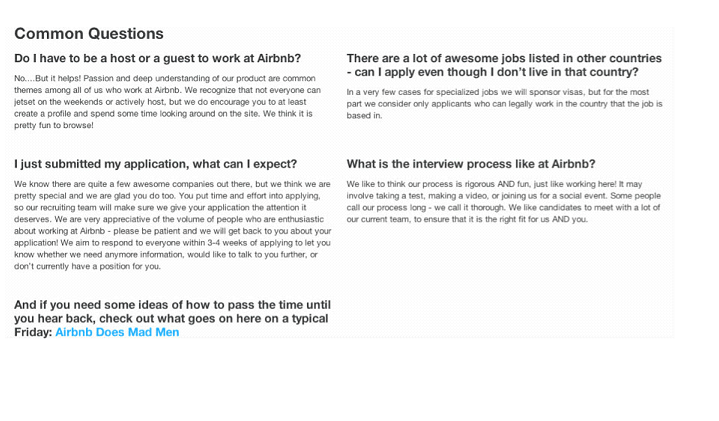
Image source: Business Solutions on LinkedIn
Another idea is to build a free learning center of the skills people need to work for you and make it accessible also to non-applicants. When you foster professional development, you attract professionals who are naturally motivated to achieve growth.
- Analyze your brand voice
Let’s talk brand voice for a minute.
A CareerBuilder study reveals that 40% of candidates believe that in the last five years, the application process has become more difficult. Of those, 57% feel “the process is too automated and lacks personalization”.
Macri mentions a great way of getting into the shoes of the candidate which is related to the way you talk to them. She and her team applied for a number of jobs to get a feeling of the communication candidates usually get from prospective employers. This way they discovered Airbnb used the exact same auto-reply messages as other companies.
Are you guilty of this mistake? According to CareerBuilder, only 31% of employers claim they verified the hiring process of employers by applying for one of their open jobs. If you’re not one of them, now would be the time to do so. Go through messages generated through your applicant tracking system and change things around so the content matches your usual tone of voice.
- Follow up regularly and at good cadence
Velocity is one of the most important metrics which talent acquisition teams universally struggle with. Recruiters are snowed under with work and they simply get back to people too late or not at all, but having too much on your plate is not an excuse
- Respect other people (and their time)
How to convey a sense of candidate-centrism? Treat people with respect – it doesn’t matter if they’re right for the job or not, they deserve to be treated nicely.
Take advantage of technology and do your best to shorten the recruitment process, i.e. by means of skill screening software. CareerBuilder research reveals that 76% of applicants want to know how long it will take them to complete the application before it even starts. Candidates know the job market is changing and they know they are now in its centre.
Jill Macri admits that rejected applicants who got past a certain stage are usually offered a coupon. That’s Airbnb’s way of thanking them for their time, which brings us to the much dreaded topic of rejection.
- Reject people respectfully and gracefully
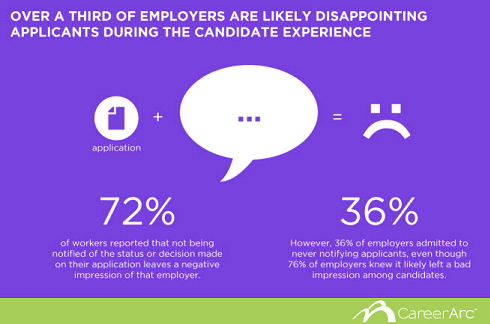
Image source: CareerArc
CareerArc reports that 36% of employers admit to never notifying applicants and a staggering 72% of workers believe that not being notified of their status in the process leaves a bad impression of the employer.
Jill Macri mentions that Airbnb rejects applicants by email with an invitation to call back for feedback because it gives people time to digest the news before they talk to someone.
- Focus on the “know” and “feel”

Image source: We Are Change
Macri mentions that upon building the new hiring model, Airbnb team focused on what they wanted candidates to know and feel at each stage. This allows them to appeal to both heart and reason which makes candidates both more confident and engaged at the same time.
- Get your company to understand the transition
Adapting the candidate-centric model is a concerted effort which is also manifested in the smallest things. It’s not a matter of simply Improving interviewing habits – the change affects the entire organization on many levels.
Jill Macri says that Airbnb wanted to “demonstrate we respected the candidate’s time. One subtle but powerful touch was writing a welcome note to candidates on the whiteboard in the interview room”. That’s one great (and cheap!) way of making applicants feel positively surprised.
Another way of doing that is to take them on a tour around the office.

Image source: Officelovin’
Macri states that because Airbnb’s culture is their strongest asset, when candidates see the employees simply doing their thing, the talent acquisition team doesn’t need to sell the company to the candidate. That’s a win-win right there.
- Keep gathering feedback
Your work is never over and you should always endeavour to make the process better for the candidates. One of the ways to do so is by running continuous surveys. Macri reports that at Airbnb, they gather candidate feedback at three stages:
- People who applied but didn’t get an interview,
- Candidates who got the interview but weren’t hired,
- Applicants were interviewed and got an offer.
Macri argues that one of the main objectives of her team is that people who first encountered the brand (were never hosts or guests) during the recruitment process have a positive experience.
Conclusion
Final word of wisdom comes from Amy Miller, Microsoft’s recruiting veteran with a 10+ years of experience. Candidate-centrism means you should be putting the candidate first also before yourself if that benefits your organization. In a Dice webinar, Miller says: “I purposefully have relationships with recruiters in other Microsoft businesses units. I’ll often say to a candidate based on what we talked about we should connect you with XYZ other recruiter”.
Try to work on limiting your “own selfish desire to fill (…) open racks out of the equation”. Work with other recruiters in the company who may have a better fit for the candidate – they are the ones who are going to do the job so if you know they’d be happier in a different team, don’t keep that knowledge to yourself. Your organization is going to thank you for it.
Share post